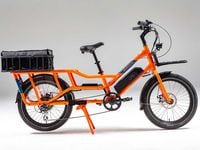Bike nerds may know that the creation of REI’s Co-op Cycles isn’t the first time the Seattle-based chain has sold its own house-label bikes. In the 1980s, REI introduced a brand called Novara. Eventually REI realized that if the outdoor co-op was going to sell bikes, it shouldn’t stock only its own private label. So today, REI moves a ton of other bicycle brands—and ebikes, too, including electrics from Tern, Cannondale, Ghost, and Yuba.
The ebike market is booming, so the fact that Co-op Cycles has been researching its own line of ebikes for years and happened to rock the timing for debuting two new ebikes in 2020 is all the more fortuitous. (And REI has hinted that more is coming from Co-op Cycles in the pedal-assist category.)
For now Co-op has debuted the Cty e2.1 and e2.2, both on the same mountain bike-esque 6061 cockpit that comes complete with an overbuilt rear rack that’s welded as a complete part of the frame (so it’ll never loosen or rattle), ergonomic grips, an adjustable stem, bell, beautiful matte paint scheme, and a battery that’s integrated in the triangle, sparing room for a water bottle cage both at the base of the seat tube and fixed to the underside of the toptube.
The whole setup looks reliable as the rain in Seattle—and wouldn’t you know it, even though I grew up in Seattle (but left long ago), my maiden ride happened to feature rain too. Still, I wasn’t worried; REI fitted the e2.2 I was testing with 1.95-inch-wide Schwalbe Big Ben tires, which have a soft, grippy compound. It was time to test a bike designed in Seattle in Seattle conditions!
There are three sizes of the Cty e2.1 and e2.2 bikes. The smallest size is a step-through, and REI says the sizes should fit riders from 5 feet tall to 6-foot-3.
Both are very close in specification. They’re Class 1 (pedal assist up to 20 mph), but the e2.1 is a bit meeker, producing 40Nm max torque from a 250W Shimano E5000 mid-drive motor powered by Shimano’s E8014 36V/418Wh battery. The e2.2. gets more mustard—60Nm of max torque—from the combination of Shimano’s 250W E6100 motor and E8010 36V/504Wh battery. The latter charges faster—four hours versus 6-1/2 hours.
The e2.2 also gets front and rear fenders, but both bikes are built on the same 6061 aluminum frame with a 75-millimeter-travel Suntour suspension fork and potent, center-locking Shimano Altus hydraulic disc brakes with large 180-millimeter rotors. The Cty models also get front and rear lights and share a nine-speed 11-34T Shimano HG200 cassette. Three modes of pedal assist are offered—Eco, Normal, and High—as well as a walk mode.
One very nice feature is that the central motorcycle-style two-legged stand stabilizes the bikes when parked, so if you’re doing what I did during a lot of rides—loading that rear rack with gear and groceries and, at one point, using the bike to shuttle camera gear to a photo shoot—you can be sure the Cty is going to stay put, even with imbalanced weight on the rack.
One of the first things I noticed about my size-medium tester is how perfectly balanced this bike feels. At 51.9 pounds, it’s not especially light, but the 60Nm of torque helped propel it easily, and at times I rode no-handed. Even with panniers loaded out back, the going was placid. The Shimano pedal assist is very natural. It falls off just shy of the 20mph limit, but re-engages smoothly, rather than in any sort of jerky fashion. Uptake is fluid, and even if you try to throw it off, by mashing at low rpm or spinning at a high cadence, you’re never out of rhythm with the aid. In the lowest Eco assist mode, you can nearly forget that you’re being goosed along.
The cockpit is also upright, but not so forced that you feel like you’re teetering on the bike—you sit within the e2.2, and I found that very quickly even technical, rocky terrain (thanks to a recent washout on one of my favorite rail trails) was painless to tackle. In fact, the more I rode the e2.2, the more I dared attempt even rugged mountain bike singletrack, motoring up one route I would normally descend, just because I could.
All that confidence doesn’t come at the cost of playfulness either. This is a fun bike! Usually a rig with such a utilitarian aim wouldn’t feel as lively, particularly at this weight, but I had no compunction about railing back down that same singletrack trail, even though, no, it wasn’t on my way home at all, but who cares? Did I mention I saw 55 miles of range, despite REI listing it at 50 miles? So, no, taking a detour wasn’t a big deal, and I should mention that the Shimano brakes and drivetrain really help a ton. The brakes were never overmatched slowing down the e2.2, even in the rain on long, steep hills. I wasn’t geared out on descents until topping 30 mph, and the 34-tooth cog at the top of the cassette let me climb just about any hill I liked.
Looking for a gripe? It would be smart for REI to extend the tail ends of both fenders, to prevent road spray from flying up, and nope, there’s no chain guard, so you will grease your jeans if you’re not careful.
The Co-op Cycles e2.2 retails for $2,199 (the e2.1 runs $1,799). You can buy it online and have it shipped directly to you, or you can shop at REI locations nationwide. The Co-op line has experienced shortages though, and REI says it will be replenishing stock as soon as possible, and has plans for much more inventory in the early part of 2021 too.


















/cloudfront-us-east-1.images.arcpublishing.com/octane/64XSRRNK7FA67IKKYNS64M2LLM.jpg)
/cloudfront-us-east-1.images.arcpublishing.com/octane/BCPI5AVRTRAGJJXFUJFTXKYPNU.jpg)
/cloudfront-us-east-1.images.arcpublishing.com/octane/SLEXAPVAUVHXJEVCOSDQ4X4V2Y.jpg)
/cloudfront-us-east-1.images.arcpublishing.com/octane/7PG4F2A5ENEC7HWN56UXSHG42E.jpg)
/cloudfront-us-east-1.images.arcpublishing.com/octane/QXIFL3IUHFF6XBKWBSOBAEYU6E.jpg)
/cloudfront-us-east-1.images.arcpublishing.com/octane/RRKZHUMAY5GUPNDVRUZTKJZIG4.jpg)
/cloudfront-us-east-1.images.arcpublishing.com/octane/UIKFUXNZBZCSBFG5RAA3JUIWJE.jpg)
/cloudfront-us-east-1.images.arcpublishing.com/octane/EFVNPX2SEFB4RKROYTCAU72MXE.jpg)
/cloudfront-us-east-1.images.arcpublishing.com/octane/3FQ52XVEGVEATIHVFKFJ5IE3WI.jpg)
/cloudfront-us-east-1.images.arcpublishing.com/octane/OMKF3TX7QFBXJJAHJYEM546MNQ.jpg)

/cloudfront-us-east-1.images.arcpublishing.com/octane/GEAFOAZUT5HC5HOVB53DXZ3NKQ.jpg)
/cloudfront-us-east-1.images.arcpublishing.com/octane/KSYPYGAGWVCWBJVTU73BN3XMSA.jpg)
/cloudfront-us-east-1.images.arcpublishing.com/octane/HVGW2KNFSFHK3GZ2VHGXDUKGVM.jpg)
/cloudfront-us-east-1.images.arcpublishing.com/octane/COGMPYKMWJFHNLRB6DPF6P5DHU.jpg)
/cloudfront-us-east-1.images.arcpublishing.com/octane/KQEPQMYNA5A73CCY5NY2QVFRBU.jpg)
/cloudfront-us-east-1.images.arcpublishing.com/octane/XKNKQTC3T5HOPBLELV2VNUDV2I.jpg)
/cloudfront-us-east-1.images.arcpublishing.com/octane/7DPPG4RP3BAA5MGASUXCALC2BA.jpg)
/cloudfront-us-east-1.images.arcpublishing.com/octane/PG3YCWOMDJD2DIMZRKEYKMDK6U.jpg)
/cloudfront-us-east-1.images.arcpublishing.com/octane/6Y2CT4BZAZFIHDXJQXLJJ4SL6A.jpg)
/cloudfront-us-east-1.images.arcpublishing.com/octane/7DIX3PDUL5GULCNQP4SP5SF474.jpg)
/cloudfront-us-east-1.images.arcpublishing.com/octane/XAFIAOLCHFHZZFWUD4DLCOGVQQ.jpg)
/cloudfront-us-east-1.images.arcpublishing.com/octane/O7O55GYQVRDGJPFSUDKNY2ZK24.jpg)
/cloudfront-us-east-1.images.arcpublishing.com/octane/I7GGEJ4RIJCBPDVPXPQLSETLCA.jpg)